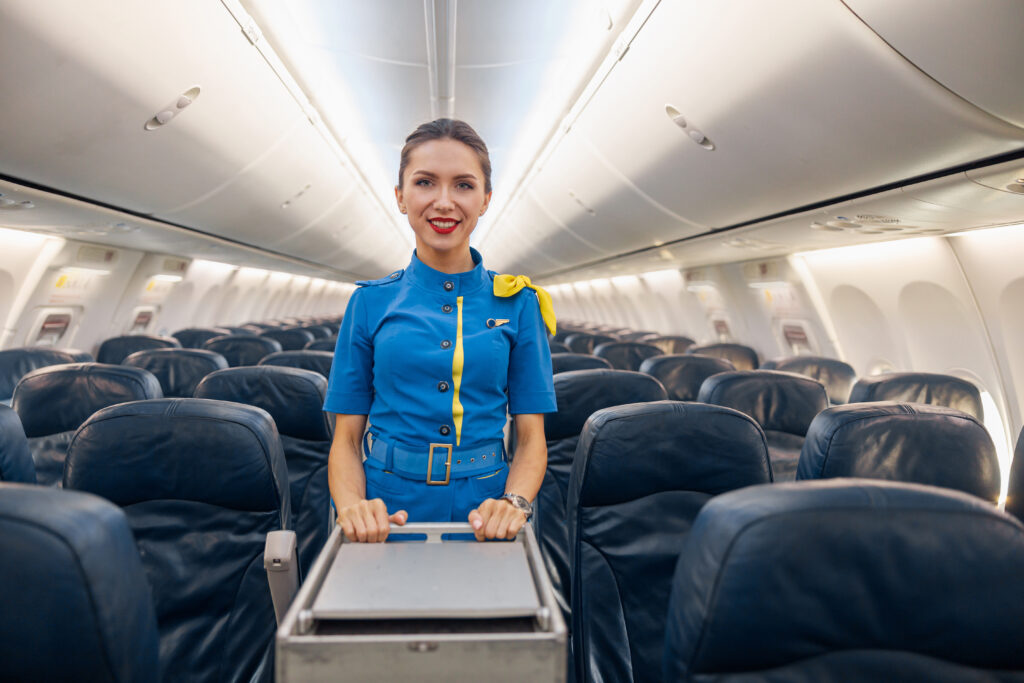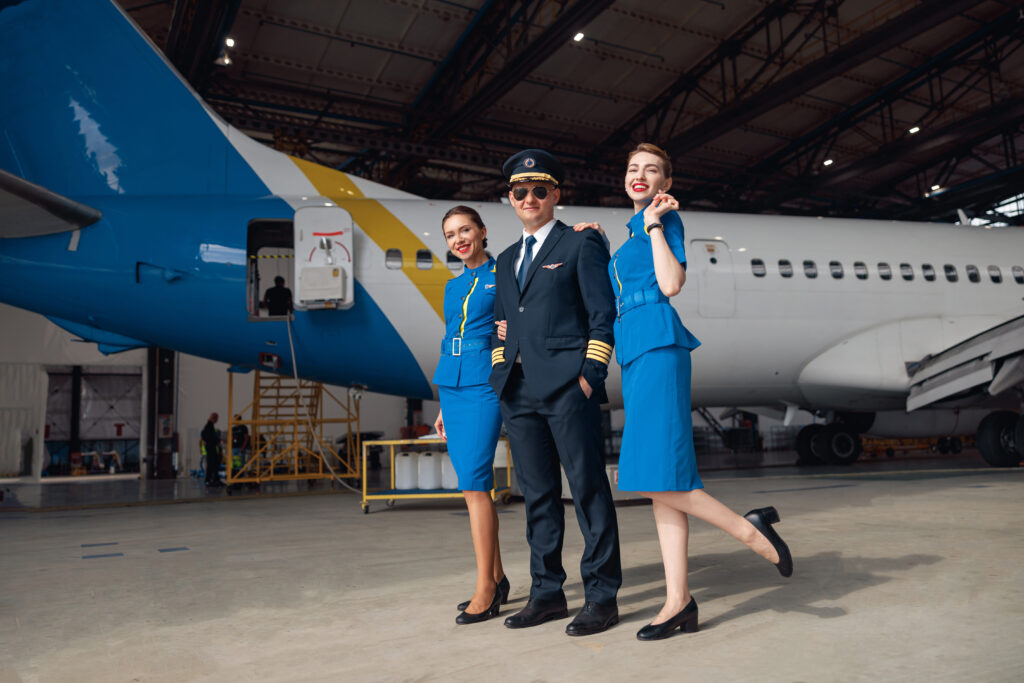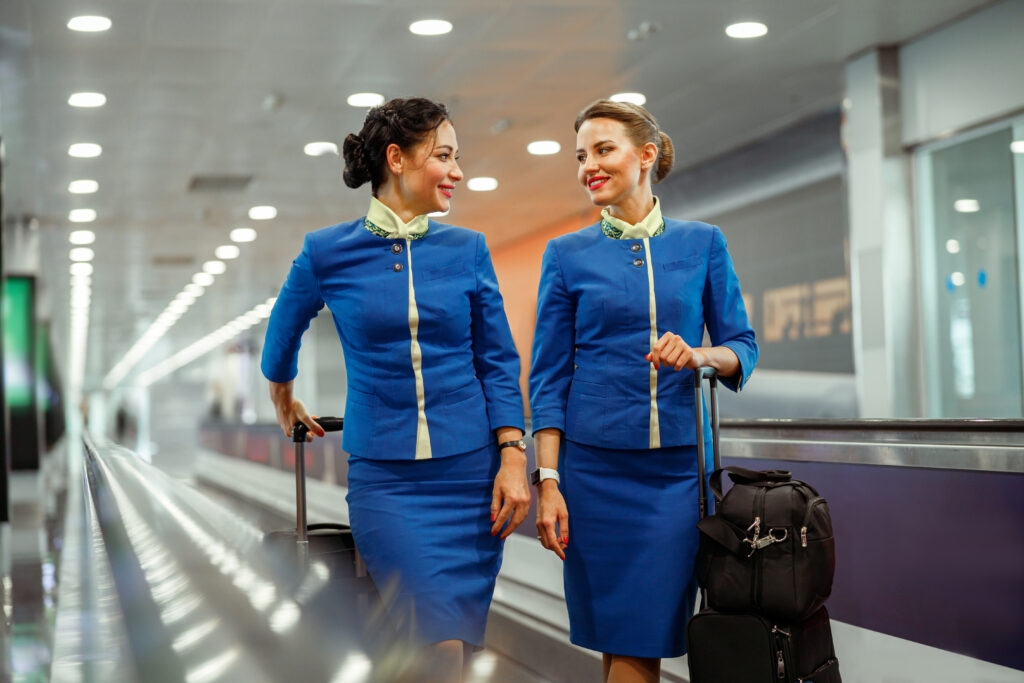A flight attendant’s uniform goes far beyond aesthetics—it’s a key element of their role as aviation professionals. From the moment a passenger boards the aircraft, the uniform conveys safety, order, and professionalism. In this section, we explore how flight attendant attire influences passenger perception and reinforces the airline’s corporate image.
Flight attendant attire is an essential part of training, as it directly influences passengers’ first impressions from the moment of visual contact.
The dress code for Cabin Crew Members (CCMs) is designed to ensure a professional, functional, and safe appearance. A well-maintained uniform inspires confidence in passengers, who associate a polished look with competence and thorough training. Additionally, the outfit must be comfortable and allow freedom of movement, while maintaining elegance and formality.
Choosing the right attire for a flight attendant interview is also crucial during the recruitment process, as it reflects the candidate’s commitment to industry standards.

Flight attendant attire goes far beyond aesthetics—it plays a vital role in their professional responsibilities within the aviation industry. From the moment passengers board the aircraft, the uniform communicates safety, order, and professionalism. In this section, we highlight how flight attendant dress standards impact passenger perception and reinforce the airline’s brand image.
The most popular colors in flight attendant uniforms include navy blue, gray, black, and red, tones that convey elegance, authority, and trust. Uniform cuts are typically classic and tailored, yet designed for comfort and freedom of movement without compromising formality. Preferred materials are durable, breathable, and easy to maintain, such as polyester, lightweight wool, or synthetic blends.
Additionally, the Cabin Crew dress code requires uniforms to be clean, well-ironed, and properly fitted at all times, avoiding excessive accessories or overly bold makeup.
Choosing the right outfit for a flight attendant interview is essential to making a positive impression. While wearing the official uniform is not required, candidates are encouraged to dress in a similar style: a tailored blazer, white blouse, closed-toe shoes, and neatly styled hair. This type of attire reflects respect for the profession and awareness of industry standards.
It’s also important to follow grooming and dress code tips provided by aviation training academies like Global Training Aviation, where future Cabin Crew Members learn to pay attention to every detail of their personal image.
While the overall design of flight attendant uniforms remains consistent across genders, there are distinct differences in cuts and accessories. The female uniform typically includes a skirt or trousers, blouse, fitted blazer, and sometimes a scarf or hat. The male uniform usually consists of trousers, shirt, tie, and a straight-cut blazer. In both cases, the Cabin Crew dress code must be followed to ensure a professional and cohesive appearance.

The Emirates flight attendant uniform is one of the most iconic in the aviation industry. Designed in sand tones that evoke desert dunes, it includes an A-line skirt or trousers, a fitted blazer, a cream chiffon scarf, and the signature red hat with a gold pin. This ensemble reflects elegance, functionality, and respect for local culture. The male uniform features a three-piece suit with red accents, such as the pocket square and tie.
Spanish airline Vueling embraces a modern and functional image. Female cabin crew uniforms include a white shirt, gray skirt or trousers, blazer, and a yellow scarf for flight attendants, while pursers wear a gray scarf. A one-piece dress has also been introduced as an alternative. In winter, a light gray coat with a front bow is worn. Male crew members wear a white shirt, gray trousers, and a dark-toned tie.
Beyond the official flight attendant uniform, personal style plays a key role in the professional presentation of Cabin Crew Members. Knowing how a flight attendant should dress also involves attention to makeup, hairstyle, footwear, and accessories, always maintaining a balance between elegance and functionality.
Footwear should be closed-toe, mid-heel (between 3 and 5 cm), comfortable, and in neutral colors such as black, navy blue, or beige. Safety and aesthetics are both priorities. Permitted accessories include small earrings, a discreet watch, and corporate scarves. The Cabin Crew dress code prohibits flashy jewelry, visible piercings, or brightly colored nails.
One of the keys to understanding how a flight attendant should dress is finding the right balance between elegance and comfort. The uniform must allow freedom of movement, be breathable, and suitable for long working hours—without compromising style or formality. That’s why the choice of fabrics, cuts, and accessories is just as important as the attitude with which the uniform is worn.

Conclusion: The Importance of Personal Presentation in a Cabin Crew Career
In commercial aviation, personal presentation is far more than a matter of aesthetics—it’s a tool for communication, safety, and professionalism. Understanding how a flight attendant should dress means recognizing that every detail—from the uniform to makeup, hairstyle, and accessories—contributes to a cohesive image that inspires passenger confidence and reflects respect for the airline. The Cabin Crew dress code sets clear standards that must be followed both in-flight and during recruitment processes.
From iconic airline uniform examples to the differences in male and female attire, every aspect helps build a strong professional identity. At Global Training Aviation, the flight attendant course emphasizes personal image care as a key component in the training of future Cabin Crew Members.
This is a key question for anyone aspiring to become a Cabin Crew Member. The answer involves wearing the official flight attendant uniform according to airline standards, following the Cabin Crew dress code, and paying attention to every detail of personal grooming: subtle makeup, neatly styled hair, closed-toe shoes, and minimal accessories.
To look like a flight attendant, it’s essential to follow the grooming and dress guidelines taught at aviation academies like Global Training Aviation. This includes dressing elegantly, maintaining a professional posture, practicing good personal hygiene, and choosing outfits that reflect both seriousness and style. Even without the official uniform, a well-coordinated formal outfit can project a similar professional image.
Interview attire for aspiring flight attendants should be formal and understated: a blazer, white blouse, closed-toe shoes, and neatly styled hair. Bright colors, heavy makeup, and large accessories are best avoided. This presentation shows respect for the profession and demonstrates awareness of the Cabin Crew dress code.
Dressing as a Cabin Crew Member requires strict adherence to presentation standards, but corporate or promotional events allow for more flexibility. In these cases, the uniform may be adapted with more modern or stylized variations, while still preserving the essence of the flight attendant look and respecting the airline’s brand image.